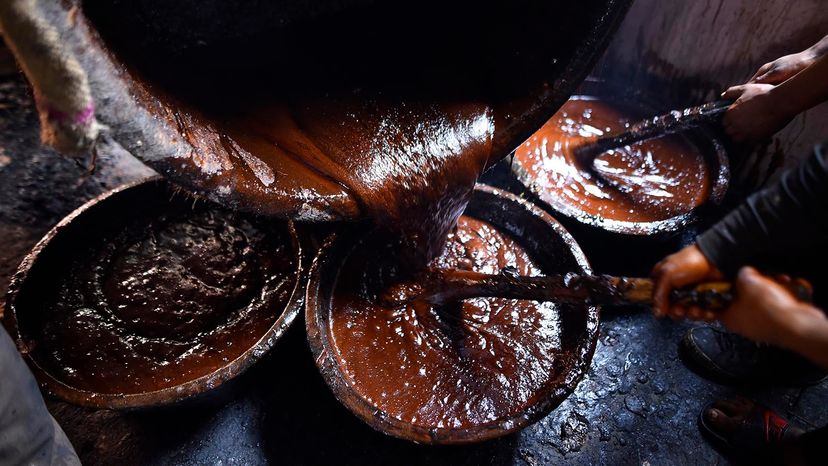 “Molasses varieties run from light to dark, depending on the amount of sugar that is extracted from successive boilings of raw sugar cane or sugar beets. Pikrepo
“Molasses varieties run from light to dark, depending on the amount of sugar that is extracted from successive boilings of raw sugar cane or sugar beets. Pikrepo
Of all the liquid sweeteners, thick, dark, viscous molasses is probably the most complex. Depending on its strength, molasses can taste from lightly sweet to smoky-sweet to harshly bittersweet, and its history is almost as complicated as its flavor.
Making molasses – the process of pressing sugar cane and boiling its juice until it crystalized – was developed in India as early as 500 B.C.E. In the Middle Ages, the concept made its way to Europe when it’s believed Arab invaders brought it to Spain. From there, molasses-making took another voyage across the Atlantic when Christopher Columbus brought sugar cane to the West Indies. Molasses also was part of the triangular slave trade of the 1600s. Slave traders would bring slaves from Africa to the West Indies in exchange for English rum. These slaves were sold to sugarcane plantations to harvest the sugar for molasses, which was then carried back to the colonies and to England. In England, molasses is often called black treacle. Because it was relatively inexpensive, up until the 1880s, molasses was the most popular sweetener in the United States.
We talked with Atlanta-based healthy chef and cookbook author Nancy Waldeck to get the 411 on molasses – the different types, ways to use it in cooking and even some of the sticky stuff’s health benefits.
"There are actually two kinds of molasses," she says. "Sugar beet molasses and sugar cane molasses. The kind we use (in cooking) is sugar cane molasses."
Sugar cane molasses has a different consistency than molasses made from sugar beets. It’s lighter (in viscosity) and sweeter. Sugar beet molasses is primarily used for animal feed and other commercial uses, such as distilling and even pharmaceuticals.
The 3 Types of Molasses
To make molasses, the plant product, sugar cane, is harvested, washed, sliced and soaked. Then the juice is extracted from the plant. At this point, the water content in the liquid is very high. The manufacturer boils the liquid to concentrate the sugars leaving a thick juice behind – a sugar syrup that is crystallized. The crystallized sugar is put in a centrifuge and spun to separate the molasses from the sugar crystals. Many cooks or cooking websites describe the process of removing the molasses from sugar crystals as "boiling." Waldeck says there are three "boils" in making molasses which produce the different types of molasses.
1. Light Molasses
The first boil creates a light syrup called cane syrup in the South. It is the lightest and sweetest variety because only a small amount of the sugar has been boiled out. It’s often used as syrup for pancakes and waffles.
2. Medium or Dark Molasses
The second boil removes even more sugar to create a medium or dark molasses which is less sweet, with a hint of bitterness, and a thicker consistency. "The second is thicker than the first," says Waldeck. "That’s typically the molasses most of us buy in the store for barbecue sauce, cookies, baking." It is the type commonly used in gingerbread.
3. Blackstrap Molasses
Blackstrap molasses is the dark syrup that results from the third extraction of sugar from the cane. It is a very strong type of molasses both in flavor and in health benefits. Because of its bitter taste, it should not be used in recipes that call for molasses.
"It’s like a lot of other foods," Waldeck says, "The more intense the color, the more nutrition it brings to the table. It’s got mostly iron and a lot of potassium for folks that need potassium for blood pressure. And like all molasses, it’s got selenium and copper, just in more concentrated amounts."
To get the nutritional benefits, Waldeck suggests stirring a tablespoon of blackstrap molasses in a quarter cup of hot water and shooting it down, rather than attempting to choke down a straight tablespoon of blackstrap molasses.
"It really depends on your palate," she says. "People who are supertasters, with a lot of taste buds and who taste foods more intensely, those folks might have trouble with blackstrap molasses and find it super bitter." The rest of us would probably end up diluting it with a glass of water afterward, anyway.
 “Molten molasses is poured to prepare chaku, a sweet made from hardened molasses, in Kathmandu, Nepal for Maghe Sankranti, the harvest festival. It is believed that consuming chaku promotes good health and warmth in the cold months. Narayan Maharjan/NurPhoto/Getty Images
“Molten molasses is poured to prepare chaku, a sweet made from hardened molasses, in Kathmandu, Nepal for Maghe Sankranti, the harvest festival. It is believed that consuming chaku promotes good health and warmth in the cold months. Narayan Maharjan/NurPhoto/Getty Images
Sulphured and Unsulphured Molasses
You may see the word "unsulphured" on a molasses bottle label. Sulphites (such as sulphur dioxide) were used as a preservative in the days before we developed advanced food production and storage techniques. It was added to molasses to prevent mold or bacterial growth. Nearly all commercial molasses is unsulphured, but food producers continue to add the word "unsulphured" to the label for marketing purposes.
Swapping Sweeteners
Waldeck says the flavor notes of molasses are totally different from that of honey, but adding molasses can be a great way to amp up the flavor of a favorite recipe.
"When you’re talking baking, it gets really sticky. That was bad," jokes Waldeck. "I wouldn’t swap out liquid sweeteners like honey or molasses for crystalized sugar. But here’s what I would do: If you wanted to bring the flavor of molasses forward, I’d use a recipe calling for honey and instead use half honey and half molasses. If that was good, I might do a second test and replace all the honey with molasses."
And if you are looking for a calorie comparison between honey and molasses, the total caloric content of the two is comparable – one tablespoon of molasses comes in with slightly fewer calories at around 58, next to 64 for a tablespoon of honey.
A favorite Waldeck ingredient – pomegranate molasses – isn’t molasses at all. It’s technically a reduction of pomegranate juice to a sticky syrup, jewel red with a sweet-tangy flavor.
"Pomegranate molasses used to be made with one ingredient – pomegranate seeds," she says. "Sometimes citric acid or some preservative was added but not always. Today it’s harder to find." Look for it in international markets.
Now That’s Interesting
Sorghum molasses is made from the sorghum plant, and not technically molasses, either. Sorghum is a grass that arrived in the U.S. with the African slave trade in the 17th century. It’s an ancient grain, a whole grain, gluten-free and eaten by millions of people in Africa and Asia.














































